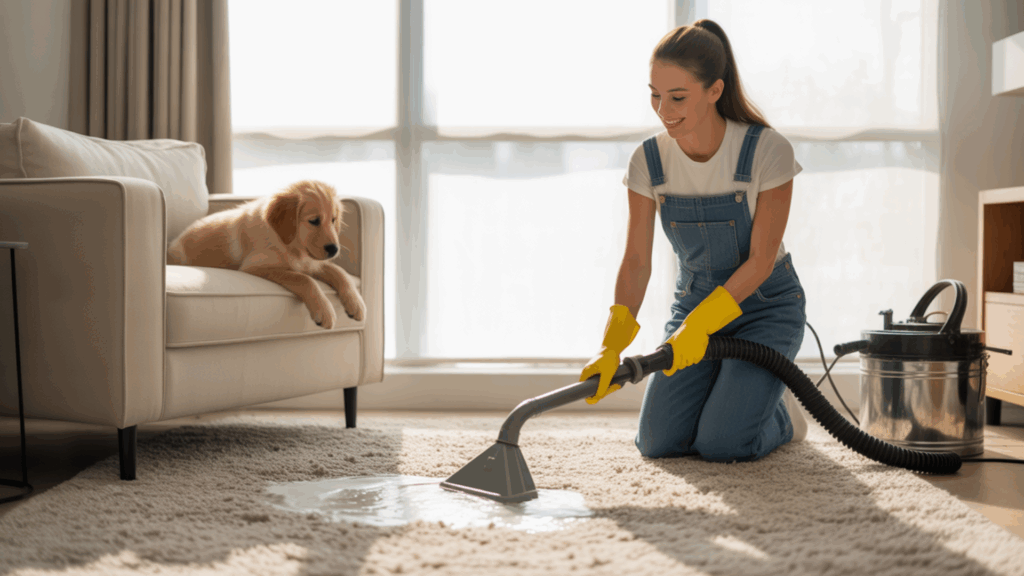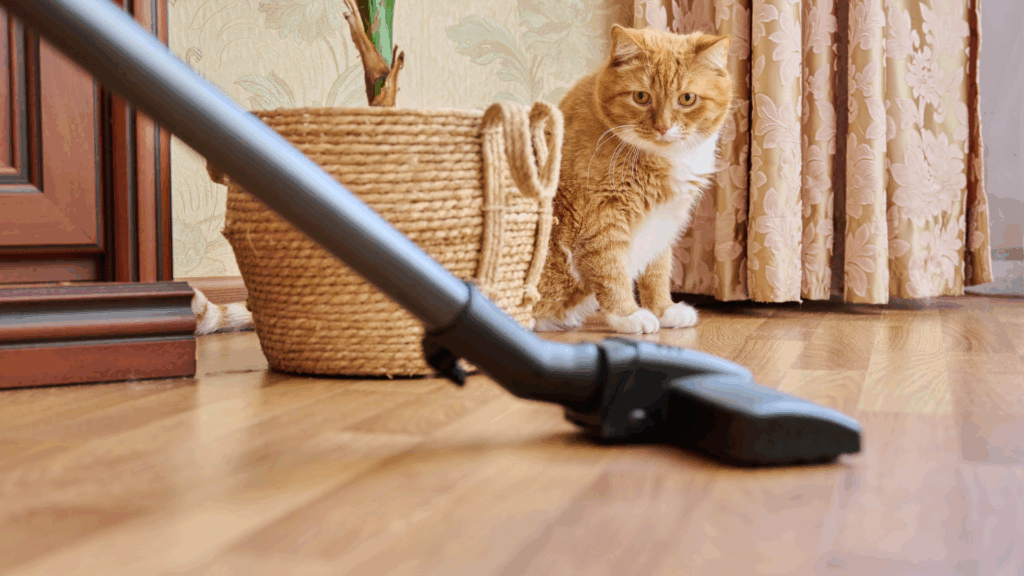Living with pets means living with smells. You love your dog or cat, but you might notice your house doesn’t always smell fresh.
In this article, I’ll walk you through simple ways to get rid of pet smell in your house. Each one is clear, easy to follow, and made for real homes like yours.
I’m not here to sell you a spray. I’m here to help you find what works. I’ve included tips that go beyond surface cleaning. These methods focus on removing the odor at its source.
If you’ve tried other tricks and still feel stuck, I hear you. I’ve been there too. You’ll find answers here – practical, honest, and useful.
Let’s fix the smell so your home smells like home again.
Why Pet Odors Linger?
Pet odors don’t just float in the air – they sink into your home. Soft surfaces, such as carpets, couches, curtains, and even your pet’s favorite blanket, absorb smells over time.
Hard surfaces, such as baseboards and floors, can also hold scent, especially if your pet has had accidents in these areas.
Hair, dander, body oils, and saliva all leave behind a trace. And while you might get used to it, guests usually notice right away.
Even if you vacuum and clean regularly, hidden smells can stay behind, especially in spots you don’t clean often – under furniture, behind doors, or in air vents.
Once these smells settle in, they don’t go away on their own. That’s why it’s important to understand where they come from – so you can tackle them the right way.
How to Get Rid of Pet Smell in the House?

If you have pets, you’ve probably noticed that no matter how clean your home looks, it doesn’t always smell that way. Pet odors can hide in carpets, furniture, and even the air.
1. Wash Pet Bedding and Soft Toys
Your pet’s bed is one of the top places where odor collects. It absorbs smells from fur, skin oils, dirt, and even little accidents. Soft toys also hold onto drool and dust.
If you don’t wash these items regularly, the smell will spread through the house. To clean them, use hot water and a mild detergent that’s safe for pets.
Add half a cup of baking soda to the wash to help break down odors. Always ensure that everything dries completely, as any leftover moisture can cause mildew and exacerbate the smell.
2. Use a HEPA Vacuum on Floors and Furniture
Pet hair and dander easily get trapped in carpets, rugs, and furniture. These particles can carry odor and even trigger allergies.
A vacuum with a HEPA filter is designed to catch very small bits that regular vacuums miss. Vacuuming at least a few times a week helps prevent the smell from building up.
Pay special attention to areas where your pet lies down or sheds the most, like corners, sofas, and under furniture.
3. Shampoo or Deep Clean Carpets
Even if you vacuum often, carpets can still trap odors deep in the fibers. Dirt, oils, and pet messes sink below the surface where vacuuming can’t reach.
Shampooing or steam cleaning pulls those smells out. For light smells, you can rent a carpet cleaner or use a home machine.
For strong odors or old pet stains, it’s best to hire a professional. Do this every few months if you have multiple pets or frequent accidents.
4. Clean Baseboards and Wall Edges
It’s easy to overlook baseboards, but they collect fur, dust, and sometimes even urine spray from male pets.
These low spots are often in contact with your pet’s body and can retain odors over time. Mix equal parts vinegar and warm water, then wipe along baseboards with a cloth.
You can also add a drop of dish soap if there’s a greasy residue. Check corners, behind furniture, and low wall trim – these areas are commonly missed during regular cleaning.
5. Wipe Down Doors, Cabinets, and Low Walls
Pets often rub their bodies or faces on doors and walls, leaving behind natural oils and fur. These surfaces may not appear dirty, but they can emit a strong odor.
Use warm water with mild dish soap and a soft cloth to gently wipe them down.
Don’t forget the backs of doors, cabinet sides, or the base of door frames – especially if your pet likes to nap nearby or scratch.
6. Wash Curtains and Fabric Blinds
Fabrics in your home, such as curtains and blinds, can trap airborne odors, especially in rooms where your pets spend a lot of time.
Over weeks, these fabrics absorb everything from body odor to dander. Remove washable curtains and throw them in the machine using a pet-safe detergent.
If your blinds are fabric-covered, use a steamer or vacuum attachment. Cleaning these soft surfaces just once a month can significantly freshen up your space.
7. Clean Air Vents and Registers
When your air system runs, it blows air through vents, and if those vents are covered in pet fur or dust, it will also spread odor.
Use a vacuum hose to remove dust from the grates, then wipe them with a damp cloth. Do this monthly, especially in rooms where your pet spends the most time.
You can even add a drop of essential oil to the cloth (make sure it’s pet-safe) for a subtle fresh scent.
8. Replace HVAC and Air Purifier Filters
Filters in your heating and cooling systems trap pet dander, fur, and dust. If they aren’t changed often, they stop working well and may even release old smells back into the air.
Check your HVAC system’s filter every month and replace it as needed. The same goes for air purifiers – if you use one to help with odor or allergies, a dirty filter makes it useless.
Look for filters with carbon layers to help absorb smell, not just dust.
9. Use Vinegar and Baking Soda in Drains
If you bathe your pet in the tub or clean pet messes in the sink, odors can settle in the drain. Over time, that smell can rise back into the room.
To clean drains naturally, pour half a cup of baking soda down the drain, followed by one cup of vinegar. Let it fizz for 10 minutes, then rinse with boiling water.
This mix breaks down the buildup and deodorizes the pipe.
10. Spray Upholstery with Pet-Safe Fabric Cleaner
Sofas, chairs, and cushions trap odor easily, especially if your pet sleeps on them. You don’t always need to wash the whole cover – fabric spray can refresh the area in between washes.
Use one that’s made for pet households and is free from harsh chemicals or heavy perfume. Spray lightly and let it air dry.
If possible, open windows after spraying to help release any lingering odor from the fabric.
11. Use a UV Blacklight to Spot Hidden Pet Accidents
Some pet accidents are difficult to see once they dry, but they still have a strong odor. A UV blacklight makes it easy to spot old urine stains on carpets, wood, or tile.
Turn off the lights and shine the UV light across your floors and walls – any dried urine will glow. Once you find the spot, clean it with an enzyme-based cleaner.
These cleaners break down the proteins that cause the smell, rather than just covering it up.
12. Place Natural Deodorizers Around the Home
Some areas require ongoing support to stay fresh. Place odor-absorbing materials, such as activated charcoal, baking soda, or zeolite, in small bowls or breathable containers around the house.
These work well in corners, closets, near litter boxes, or beside pet beds. They don’t add scent – they pull odor from the air.
Change or refresh them every couple of weeks to keep them working.
13. Bathe Your Pet with Odor-Control Shampoo
Even a clean home can smell if your pet is stinky. A regular bath schedule helps remove oils and dirt from their fur.
Use a shampoo specifically designed for pets that helps control odor, rather than just masking it. Be cautious not to bathe your dog too frequently – once a month is usually sufficient for most dogs.
Cats typically do not need bathing unless they’re filthy. Always dry your pet completely to prevent musty smells.
14. Add a Doormat and Wipe Paws After Walks
Pets track in mud, pollen, and who knows what from outside. All of that can lead to smells on your floors and rugs.
Keep a doormat at each entry, and train your pet to wait while you wipe their paws with a towel or pet-safe wipe.
You can even keep a spray bottle of water and vinegar near the door to spritz muddy paws before wiping.
15. Switch to a Covered, Self-Cleaning Litter Box
For cat owners, litter box odor is one of the most difficult smells to conceal. Covered litter boxes trap odors more effectively and provide your cat with more privacy.
Self-cleaning boxes take it a step further – they scoop out waste after every use, keeping the box much fresher.
Use unscented, low-dust litter and scoop at least once a day. Place a deodorizer or charcoal filter inside the box area to control smell between cleanings.
How to Prevent Future Pet Odors?
With a few simple habits and wise choices, you can keep your space fresh without having to constantly deep clean. Below are easy ways to stop pet odors before they start.
- Stick to a regular cleaning schedule: Vacuum floors and furniture a few times a week to stay ahead of fur and dander buildup.
- Wash pet bedding and blankets weekly: These fabrics quickly collect body oils, drool, and odors.
- Mop hard floors and wipe baseboards monthly: This helps remove hair, dirt, and odor that accumulate in low-lying areas.
- Use washable covers on sofas and chairs: Covers make cleanup easier and prevent fabric from locking in smells.
- Place covers where your pet likes to rest: Focus on the couches, chairs, or beds they use regularly.
- Train pets to stay off soft furniture: Set boundaries early to reduce odor transfer to cushions and pillows.
- Clean high-touch spots like doormats and rugs: These collect outdoor smells and should be washed often.
Quick Tips for Different Pets
Every pet has its unique habits and ways of making your house smell. What works for a dog may not be effective for a cat, and small pets have their own unique needs as well.
| Pet Type | Tip | Reason |
|---|---|---|
| Dogs | Keep a towel or pet wipe by the door to wipe their paws after walks. | Prevents dirt and outdoor smells from entering the home. |
| Cats | Place litter boxes away from vents and fans. | Prevents odors from spreading through the air system. |
| Small Pets | Change cage bedding 2-3 times a week. | Prevents strong odors from building up in small spaces. |
Conclusion
Pet smell is a regular part of having animals in the house, but that doesn’t mean you have to live with it.
With the proper steps, you can get ahead of it and keep your home smelling clean. From deep cleaning fabrics to placing natural deodorizers, every small effort adds up.
Try a mix of methods to see what works best in your space. Some smells need a deeper clean, while others need a quick fix. The key is staying consistent.
Ultimately, it’s about making your home feel comfortable for both you and your pets.
A fresh-smelling house is possible – and it starts with the choices you make today.

